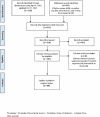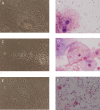Scoping review of cytolytic vaginosis literature
- PMID: 36701339
- PMCID: PMC9879469
- DOI: 10.1371/journal.pone.0280954
Scoping review of cytolytic vaginosis literature
Abstract
Background: Cytolytic vaginosis (CV) is a little-known, controversial condition that is typically not considered for women presenting with vulvovaginitis symptoms. Objective: The objective of this scoping review was to identify and compile the global evidence on CV.
Methods: A medical librarian searched Prospero, Wiley Cochrane Library, Ovid Embase, Ovid Medline, EBSCO CINAHL, ProQuest Dissertations and Theses Global, and Scopus, from inception to April 4, 2019 and updated to October 17, 2021. Studies were eligible if they discussed CV. Two independent reviewers conducted study selection and data extraction.
Results: Sixty-four studies were identified, with 67% of studies (n = 43) published since 2007. Studies were from around the world, including the United States (28%, n = 18), Brazil (11%, n = 7), Portugal (11%, n = 7), and China (11%, n = 7). Fifty percent of studies (n = 32) were reviews; the remainder were observational; and of these, 78% (n = 25) were cross-sectional. The most frequent topics included: diagnosis (19%, n = 12), prevalence (17%, n = 11), and overview of CV (50%, n = 32). Evidence for prevalence in symptomatic women (median prevalence of 5%, interquartile range 3%-8%) was based only on 16% of studies (n = 10) with minimal evidence on prevalence in asymptomatic women and across different geographic regions. Microbiological findings, including abundant lactobacilli and fragmented epithelial cells, were found useful to distinguish between CV and vulvovaginal candidiasis, and Lactobacillus crispatus was noted to dominate the vaginal flora in women with CV. Most studies used subjective criteria to diagnose CV as the condition lacks gold-standard microscopic criteria. The suggested primary treatment (baking soda irrigations) was largely based on expert opinion, and there was minimal evidence on associations between CV and other conditions.
Conclusion: Knowledge gaps currently exist in all realms of CV research. Additional research is needed to confirm the validity of CV and ensure that women are diagnosed and treated effectively.
Copyright: © 2023 Kraut et al. This is an open access article distributed under the terms of the Creative Commons Attribution License, which permits unrestricted use, distribution, and reproduction in any medium, provided the original author and source are credited.
Conflict of interest statement
The authors have declared that no competing interests exit.
Figures



Similar articles
-
Cytolytic vaginosis: a common cause of cyclic vulvovaginitis.Nurse Pract Forum. 1992 Sep;3(3):145-8. Nurse Pract Forum. 1992. PMID: 1472886
-
Interpretation of vaginal metagenomic characteristics in different types of vaginitis.mSystems. 2024 Mar 19;9(3):e0137723. doi: 10.1128/msystems.01377-23. Epub 2024 Feb 16. mSystems. 2024. PMID: 38364107 Free PMC article.
-
Vulvovaginitis: screening for and management of trichomoniasis, vulvovaginal candidiasis, and bacterial vaginosis.J Obstet Gynaecol Can. 2015 Mar;37(3):266-274. doi: 10.1016/S1701-2163(15)30316-9. J Obstet Gynaecol Can. 2015. PMID: 26001874
-
Vaginal microbiome.Ceska Gynekol. 2018 Winter;83(5):371-379. Ceska Gynekol. 2018. PMID: 30848142 Review. English.
-
Evaluation of vaginal complaints.JAMA. 2004 Mar 17;291(11):1368-79. doi: 10.1001/jama.291.11.1368. JAMA. 2004. PMID: 15026404 Review.
Cited by
-
Comparison of the lower genital tract microbiome composition in patients with benign gynecological disease.Front Glob Womens Health. 2025 Jan 21;6:1507907. doi: 10.3389/fgwh.2025.1507907. eCollection 2025. Front Glob Womens Health. 2025. PMID: 39911698 Free PMC article.
-
Vulvovaginitis in pregnant women.Rev Bras Ginecol Obstet. 2024 Apr 2;46:e-FPS03. doi: 10.61622/rbgo/2024FPS03. eCollection 2024. Rev Bras Ginecol Obstet. 2024. PMID: 38765512 Free PMC article. Review.
-
Molecular Testing for the Diagnosis of Bacterial Vaginosis.Int J Mol Sci. 2023 Dec 28;25(1):449. doi: 10.3390/ijms25010449. Int J Mol Sci. 2023. PMID: 38203620 Free PMC article. Review.
-
Vaginal Microbiota and Proinflammatory Status in Patients with Polycystic Ovary Syndrome: An Exploratory Study.J Clin Med. 2024 Apr 15;13(8):2278. doi: 10.3390/jcm13082278. J Clin Med. 2024. PMID: 38673551 Free PMC article.
-
Extracellular Traps in Patients Diagnosed With Bacterial Vaginosis, Trichomoniasis, Candidiasis, Noninfectious Vaginitis and Cytolytic Vaginosis.Int J Microbiol. 2024 Oct 23;2024:7619416. doi: 10.1155/2024/7619416. eCollection 2024. Int J Microbiol. 2024. PMID: 39479185 Free PMC article.
References
-
- Peebles K, Velloza J, Balkus JE, McClelland RS, Barnabas RV. High global burden and costs of bacterial vaginosis: a systematic review and meta-analysis. Sex Transm Dis. 2019. May;46:304–311. - PubMed
-
- Bilardi JE, Walker S, Temple-Smith M, McNair R, Mooney-Somers J, Bellhouse C, et al.. The burden of bacterial vaginosis: women’s experience of the physical, emotional, sexual and social impact of living with recurrent bacterial vaginosis. PLOS ONE. 2013;8:e74378. doi: 10.1371/journal.pone.0074378 - DOI - PMC - PubMed
Publication types
MeSH terms
LinkOut - more resources
Full Text Sources
Miscellaneous

